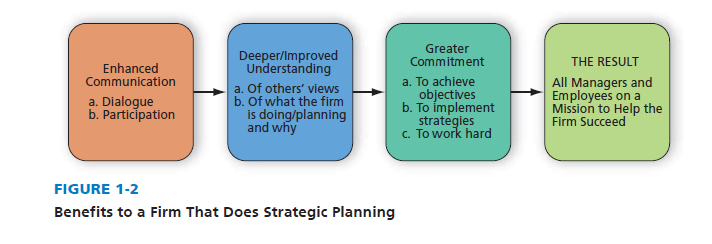Strategic management allows an organization to be more proactive than reactive in shaping its own future; it allows an organization to initiate and influence (rather than just respond to) activities—and thus to exert control over its own destiny. Small business owners, chief executive officers, presidents, and managers of many for-profit and nonprofit organizations have recognized and realized the benefits of strategic management.
Historically, the principal benefit of strategic management has been to help organizations formulate better strategies through the use of a more systematic, logical, and rational approach for decision making. In addition, the process, rather than the decision or document, is also a major benefit of engaging in strategic management. Through involvement in the process (i.e., dialogue and participation), managers and employees become committed to supporting the organization. Communication is a key to successful strategic management. communication may be the most important word in management. Figure 1-2 illustrates this intrinsic benefit of a firm engaging in strategic planning. Note that all firms need all employees “on a mission” to help the firm succeed.
Dale Mcconkey said, “Plans are less important than planning.” The manner in which strategic management is carried out is therefore exceptionally important. A major aim of the process is to achieve understanding and commitment from all managers and employees. Understanding may be the most important benefit of strategic management, followed by commitment. when managers and employees understand what the organization is doing and why, they often feel a part of the firm and become committed to assisting it. This is especially true when employees also understand links between their own compensation and organizational performance. Managers and employees become surprisingly creative and innovative when they understand and support the firm’s mission, objectives, and strategies. a great benefit of strategic management, then, is the opportunity that the process provides to empower individuals. Empowerment is the act of strengthening employees’ sense of effectiveness by encouraging them to participate in decision making and to exercise initiative and imagination, and rewarding them for doing so. William Fulmer said, “You want your people to run the business as it if were their own.”
Strategic planning is a learning, helping, educating, and supporting process, not merely a paper-shuffling activity among top executives. Strategic-management dialogue is more important than a nicely bound strategic-management document. The worst thing strategists can do is develop strategic plans themselves and then present them to operating managers to execute. Through involvement in the process, line managers become “owners” of the strategy. Ownership of strategies by the people who have to execute them is a key to success!
Although making good strategic decisions is the major responsibility of an organization’s owner or chief executive officer, both managers and employees must also be involved in strategy formulation, implementation, and evaluation activities. Participation is a key to gaining commitment for needed changes. An increasing number of corporations and institutions are using strategic management to make effective decisions. But strategic management is not a guarantee for success; it can be dysfunctional if conducted haphazardly.
1. Financial Benefits
Organizations that use strategic-management concepts are generally more profitable and successful than those that do not. Businesses using strategic-management concepts show significant improvement in sales, profitability, and productivity compared to firms without systematic planning activities. High-performing firms tend to do systematic planning to prepare for future fluctuations in their external and internal environments. Firms with management systems that utilize strategic-planning concepts, tools, and techniques generally exhibit superior long-term financial performance relative to their industry.

High-performing firms seem to make more informed decisions with good anticipation of both short- and long-term consequences. In contrast, firms that perform poorly often engage in activities that are shortsighted and do not reflect good forecasting of future conditions. Strategists of low-performing organizations are often preoccupied with solving internal problems and meeting paperwork deadlines. They typically underestimate their competitors’ strengths and overestimate their own firm’s strengths. They often attribute weak performance to uncontrollable factors such as a poor economy, technological change, or foreign competition.
More than 100,000 businesses in the United States fail annually. Business failures include bankruptcies, foreclosures, liquidations, and court-mandated receiverships. Although many factors besides a lack of effective strategic management can lead to business failure, the planning concepts and tools described in this text can yield substantial financial benefits for any organization.
2. Nonfinancial Benefits
Besides helping firms avoid financial demise, strategic management offers other tangible benefits, such as enhanced awareness of external threats, improved understanding of competitors’ strategies, increased employee productivity, reduced resistance to change, and a clearer understanding of performance-reward relationships. Strategic management enhances the problem-prevention capabilities of organizations because it promotes interaction among managers at all divisional and functional levels. Firms that have nurtured their managers and employees, shared organizational objectives with them, empowered them to help improve the product or service, and recognized their contributions can turn to them for help in a pinch because of this interaction.
In addition to empowering managers and employees, strategic management often brings order and discipline to an otherwise floundering firm. It can be the beginning of an efficient and effective managerial system. Strategic management may renew confidence in the current business strategy or point to the need for corrective actions. The strategic-management process provides a basis for identifying and rationalizing the need for change to all managers and employees of a firm; it helps them view change as an opportunity rather than as a threat. Some nonfinancial benefits of a firm utilizing strategic management, according to Greenley, are increased discipline, improved coordination, enhanced communication, reduced resistance to change, increased forward thinking, improved decision making, increased synergy, and more effective allocation of time and resources.16
Source: David Fred, David Forest (2016), Strategic Management: A Competitive Advantage Approach, Concepts and Cases, Pearson (16th Edition).

Way cool! Some extremely valid points! I appreciate you writing this write-up and also the rest of
the website is really good.